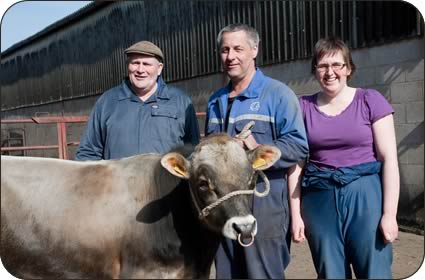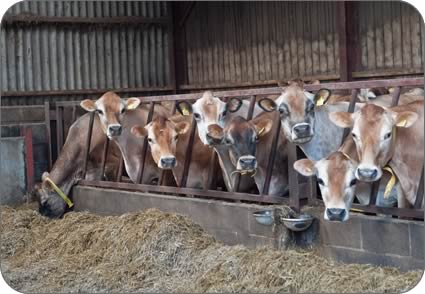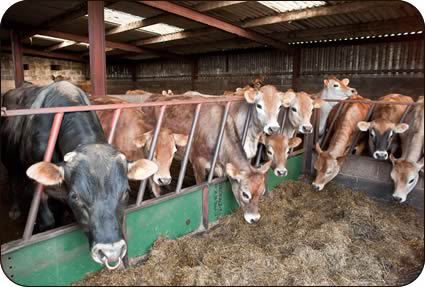Jennifer MacKenzie is an agricultural photo journalist with almost 30 year's experience. Operating from her base in Cumbria, Jennifer undertakes mainly industry-related freelance writing and photography.
50th Anniversary of Farlam Jerseys
Selective breeding for milk quality helps ensure the viability of a Cumbrian
family’s herd of 80 Jersey cows.
This year marks the 50th anniversary of the Farlam herd based at Farlam Hill, near Brampton, and Caroline and John Elliott and Caroline’s parents Arnold and Mary Thompson are as committed to the breed as ever.
 |
| Left to right, Arnold Thompson, John and Caroline Elliott with six month old bull Farlam Ellens TV ED |
The milkers are run as one but comprise the Farlam herd which topped the revived Cumbria NMR milk records contest for the breed’s highest combined weight of butterfat and protein and Caroline and John’s smaller herd which has achieved accolades for individual cows.
The 52 milkers in the Farlam herd topped the NMR Jersey tables for Cumbria to the end of September 2011 with a combined weight of fat and protein of 647kg. The 52 milkers averaged 6,151kg of milk at 6.32% butterfat and 4.19 protein. With their milk buyer J and E Dickinson, of Holmfirth, paying a premium for constituent values, the family’s aim is to breed for milk solids, not volume.
The Farlam herd was started by Arnold’s father John in 1962 from local herds and dispersal sales and the easily managed Jerseys were soon proved firm favourites at Farlam Hill over black and whites.
 |
| Jersey heifer calves |
Herd numbers and production have been gradually increased over the decades and cows were increased to 80 when the farm’s enclosed fell was sold to the RSPB post foot and mouth and the flock of 350 Swaledales was also sold. The family took the opportunity to buy their neighbouring farm and now run 200 owner occupied acres.
“We like our Jersey cows. We look after them and they look after us,” said Caroline, whose daughters, Rachel, 17, who works for Burnetts Solicitors in Carlisle, and twins Emily and Laura, 15, take an interest in the herd and they started their Cumbrian herd in 2007.
“We make a good living off only 80 cows which isn’t many to keep two families but it works well,” she added.
“Our priority is to produce butterfat and protein and it starts with the breeding and continues with feeding and general management,” said John.
“Until recently, we have been using Danish bulls but we have been finding it extremely difficult to get outcrosses which give us the high milk solids we need because of the North American influence, so now we are trying New Zealand bloodlines from LIC and Avoncroft to help maintain milk quality,” he added.
 |
| Jersey cows in milk at Farlam Hill Farm |
“Herd milk yields have increased over the years - it averaged 5,139kg in 1985, 1,000kg less than last year - and butterfat and protein has also increased, but if we pushed for volume we would lose the milk solids. Our aim is to have the solid content at an average of 700kg but it’s a fine juggling act,” said John. “Jerseys are not intended for high volume production.”
According to UK Jerseys, the current breed average is 5,513 kgs milk at 5.41% butterfat and 3.82% protein.
Maiden heifers are on the ground by two New Zealand sires, Royals Green Daylight and Hillstar Maunga Junior and will be bulled this autumn.
Three straws of semen from a Danish bull last used almost 30 years ago, Fyn Tved, one of the highest fat and protein Jersey bulls in the 1980s, has produced a bull and a heifer calf from three cows.
The bull, will be used to serve the maiden heifers. Farlam Ellens Tved, out of Farlam Zebus Ellen, is predicted to increase fat and protein by 0.34% and 0.10% respectively. Farlam Zebus Ellen goes back to one of the herd’s most successful cows on the sire line, Farlam Danish Tanda and she has given up to 7.49% butterfat and 4.22% protein.
A cow from one of the successful original families, Farlam Danish Tanda was the highest scored brood cow winning 12 star gold from the Jersey Cattle Society on progeny, production and inspection in April 2010. She was in production until she was 13 years old.
Last year Farlam Yawns Ada won the UK Jerseys Beautys Trophy for the highest lifetime kg of butterfat from a cow passing 50,000kg of milk. By her ninth lactation she had produced 53,274kg of milk, 3,609kg of which was butterfat.
Farlam Barbaras Erica was third in the Raylands Tropy for the highest kg of butterfat and protein at 783kg in her fifth lactation while she was fourth in the Wheldon Trophy for the highest kg of fat and protein in three consecutive lactations (three to five at 2,293kg).
 |
| Jersey heifers with two and a half year old stock bull Farlam Crocuss Lirsk |
Most successful in the Tarn herd was the Secretary’s Trophy winner in 2011, Tarn Vines X 5, which in 12 lactations produced 69,231kg at 7.10 butterfat and 4.34 protein, a combined yield of 7,932kg of fat and protein.
The longevity of the herd also ensures that there are up to 25 newly calved heifers for sale either privately or through the Lakes Jersey Club sales at Borderway Mart, Carlisle. Last year a calved heifer sold for 1,800gns and her heifer calf sold for 480gns.
Herd replacements average 10 a year and a number of the herd are in their eighth and ninth lactations.
Youngstock go out after first cut silage which with the year round calving herd means that some will be housed for a year. Heifers calve at two years old to start “paying their way”.
Bulls are also sold off the farm and cattle sales account for up to a quarter of the herd’s income.
Danish sires used most recently on the herd have included DJ Hulk, Q Handix, Q Hov, Q Lic, Q Zik and DJ Lirsk.
A son of Lirsk, Farlam Crocuss Lirsk at two and a half, is the herd’s youngest stock bull. Ellerdine Rebels Rascal the second stock sire, is six years old.
The family pays close attention to detail in the management and feeding of the herd. the diet is kept simple, a silage and wholecrop barley based feed, fed at a ratio or 2:1 through a forage box.
The summer ration includes 10kg a head of wholecrop and 1kg of sugar beet pulp. They are fed up to 6kg a day of 18 per cent protein dairy concentrate from Jim Peet Agriculture, with none getting less than 4kg to maintain fat and protein.
The cows have access to as much grass as they can eat during the day but have the feed in front of them at night with the option to run out on 15 acres. The restriction helps them to eat extra wholecrop, which last year was 32% DM and 11.5% protein.
The grass is cut long by local contractor Duncan Maughan with a forage box to help rumen acrtivity. First cut is made off 55-60 acres and last year was up to 70 D value, 13.5% protein at 30% dry matter. The wholecrop spring barley is undersown with grass to given an annual re-seed.
Second calvers and above are watched closely for any sign of milk fever. The herd has ben closed for 20 years plus and as a result has a high health status.

